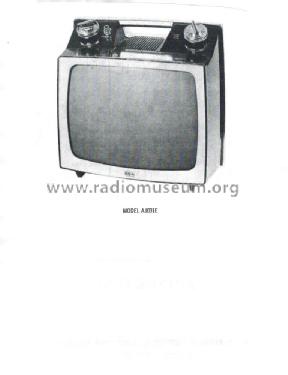- Land
- USA
- Hersteller / Marke
- RCA (RCA Victor Co. Inc.); New York (NY)
- Jahr
- 1966
- Kategorie
- Fernseh-Empfänger/Monitor
- Radiomuseum.org ID
- 150139
-
- anderer Name: RCA Manufacturing || Victor Talking Machine
- Anzahl Röhren
- 1
- Röhren
- unknown_Tube
- Anzahl Transistoren
- 26
- Halbleiter
- Hauptprinzip
- Superhet allgemein
- Betriebsart / Volt
- Wechselstromspeisung
- Lautsprecher
- Dynamischer LS, keine Erregerspule (permanentdynamisch)
- von Radiomuseum.org
- Modell: KCS153X - RCA RCA Victor Co. Inc.; New
- Form
- Tischgerät ohne Drucktasten, bis 35 cm Breite (Kleingerät, meist dekorativ. Nur für Netzbetrieb, doch Transportgriff möglich).
- Abmessungen (BHT)
- 13 x 12.25 x 10.9 inch / 330 x 311 x 277 mm
- Bemerkung
- The RCA model KCS153X is most probably the first IC television set. According to the "PS buyer's guide to small-screen transistor portable TV's" in "Popular Science" on page 111 (December 1966) the KCS153X uses 26 transistors, 17 diodes, 1 vacuum rectifier and the IC CA3013 from RCA. The CA3013 is used for the tonal IF incl. limiter, FM detection and audio amplification. The diagonal inches of the screen: 12 (74 square inches). Heathkit GR-104 is also named as TV-kit fitted with an IC at that time and in Spring 1967 Heathkit sold the AR-15 AM-FM radio with two ICs CA3012 from RCA. According to "Funkgeschichte" the KCS153X was the first application of an IC for radio or/and television ever, presented in March 1966 (but market introduction was later that year. According to "Electronics World" from November 1966 on page 44 to 46 it was General Electric which introduced then the first IC radio ever as model P1740. Philips was the follower in Europe for an IC radio - with the model IC2000 - introduction "Funkausstellung" 1967 and Blaupunkt with it's TV set "Sevilla" "Hannover-Messe" 1967 - with the CA3012 from RCA.
- Originalpreis
- 130.00 $
- Literaturnachweis
- Funkgeschichte der GFGF (number 86, year 1992, page 245)
- Literatur/Schema (1)
- Photofact Folder, Howard W. SAMS (957-2 (1968))
- Autor
- Modellseite von Ernst Erb angelegt. Siehe bei "Änderungsvorschlag" für weitere Mitarbeit.
- Weitere Modelle
-
Hier finden Sie 5142 Modelle, davon 3248 mit Bildern und 4180 mit Schaltbildern.
Alle gelisteten Radios usw. von RCA (RCA Victor Co. Inc.); New York (NY)
